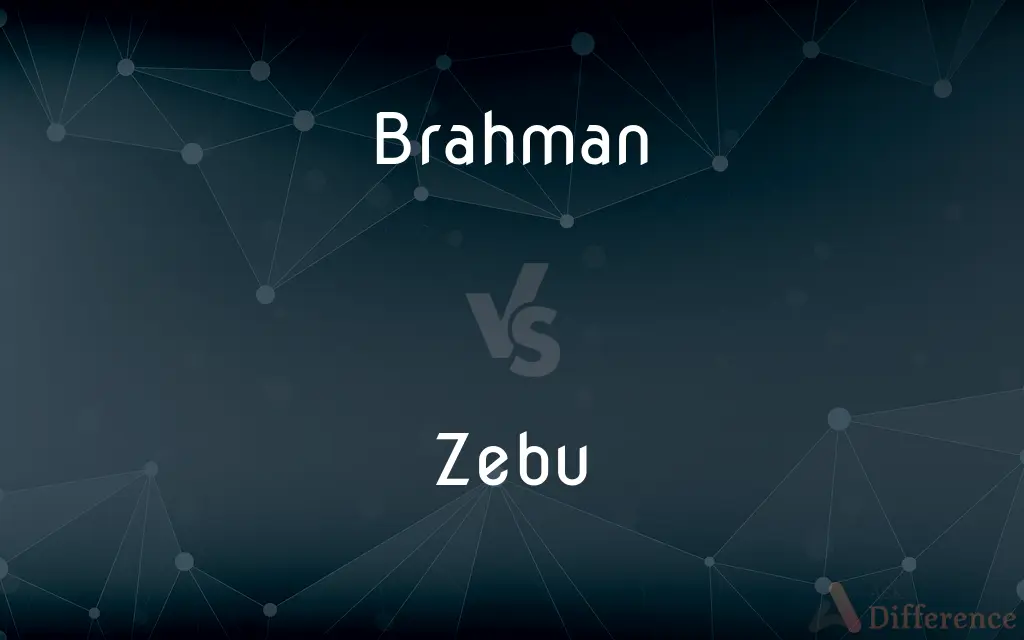Brahman vs. Zebu — What's the Difference?
By Tayyaba Rehman & Urooj Arif — Updated on March 19, 2024
Brahman cattle are a breed derived from the Zebu, known for their hump and heat tolerance, whereas Zebu refers to a species of domestic cattle originating in South Asia, characterized by their distinctive hump.

Difference Between Brahman and Zebu
Table of Contents
ADVERTISEMENT
Key Differences
Brahman cattle are a specific breed developed in the United States from four strains of Indian Zebu cattle, known for their distinctive large hump over the shoulders, loose skin, and drooping ears. They are highly valued for their adaptability to high temperatures and resistance to pests and diseases. On the other hand, Zebu, also known as Bos indicus, encompasses a wider category of hump-backed cattle native to South Asia, with many breeds including the Brahman, Gir, and Indu-Brasil, among others.
The Brahman breed, with its gray or red color, has been specifically bred for qualities such as feed efficiency, heat tolerance, and high fertility. Zebu cattle, in general, share these traits but can vary significantly in appearance, size, and color based on the specific breed and region they are from.
Brahman cattle have played a significant role in the improvement of beef cattle breeds worldwide, especially in tropical regions. They are often crossed with British or European breeds to produce hybrids that inherit the Brahman's heat tolerance and the superior meat quality of European breeds. Zebu cattle, while also used for crossbreeding, are more commonly found in their native regions and are utilized for a variety of purposes, including draft work, milk, and meat production.
In terms of temperament, Brahman cattle are often noted for their intelligence and docility, traits that have been enhanced through selective breeding. Zebu cattle, depending on the breed, can vary in temperament from docile to more aggressive, largely influenced by their environment and breeding.
Both Brahman and Zebu cattle have been integral to the development of efficient, sustainable livestock farming in hot climates, contributing significantly to the agricultural economy in these regions. Their ability to thrive in challenging environments makes them invaluable to farmers facing harsh climate conditions.
ADVERTISEMENT
Comparison Chart
Origin
Developed in the United States from Indian Zebu cattle
Native to South Asia
Key Traits
Large hump, loose skin, drooping ears
Distinctive hump, varies in size and appearance by breed
Color
Commonly gray or red
Varies widely depending on the breed
Use
Beef production, crossbreeding
Draft, milk, meat, and crossbreeding
Adaptability
High tolerance to heat and pests
Generally high heat tolerance and disease resistance
Temperament
Known for intelligence and docility
Varies by breed, from docile to more aggressive
Global Influence
Significant in improving beef breeds worldwide
Predominantly influential in native and tropical regions
Compare with Definitions
Brahman
A breed of Zebu cattle developed in the U.S., known for its adaptability to high temperatures and resistance to pests.
The Brahman cattle at the farm thrived despite the sweltering heat, showcasing their robust adaptability.
Zebu
A species of domestic cattle originating from South Asia, characterized by a distinctive hump on their backs.
Zebu cattle, with their notable hump and resistance to heat, are a common sight in the landscapes of South Asia.
Brahman
Primarily raised for beef production and known for their ability to improve other breeds through crossbreeding.
Crossbreeding Brahman with Angus cattle has resulted in a hardy and productive offspring, popular among ranchers.
Zebu
Includes a wide range of breeds with diverse sizes, colors, and temperaments suited to various purposes.
From the diminutive Vechur to the imposing Gir, Zebu cattle encompass a broad spectrum of breeds each adapted to its locale.
Brahman
Characterized by a large hump, loose skin, and drooping ears, which contribute to their distinctive appearance.
The Brahman's large hump and loose, pendulous skin are not just distinctive features but also aid in their heat tolerance.
Zebu
Zebu are utilized for draft work, milk, meat production, and also for their skins in certain regions.
In addition to providing milk and meat, Zebu cattle are often employed in agriculture for their strength in plowing fields.
Brahman
Brahman cattle are often noted for their intelligence and docility, traits favored by cattle breeders.
The docility and intelligence of Brahman cattle make them a preferred choice for ranchers looking for manageable livestock.
Zebu
They possess a natural resilience to high temperatures and diseases, making them suited to tropical climates.
The Zebu's resilience to diseases and ability to withstand heat make them indispensable to farmers in tropical regions.
Brahman
Their remarkable adaptability to various environmental conditions makes them invaluable in tropical climates.
Brahman cattle's ability to thrive in diverse climates has led to their widespread popularity across tropical regions.
Zebu
While predominantly found in South Asia and Africa, Zebu genetics have influenced cattle breeding worldwide.
The genetic traits of Zebu cattle have been integrated into various hybrid breeds, enhancing heat tolerance in non-native regions.
Brahman
Brahman (Sanskrit: ब्रह्मन्) connotes the highest Universal Principle, the Ultimate Reality in the universe. In major schools of Hindu philosophy, it is the material, efficient, formal and final cause of all that exists.
Zebu
The zebu (; Bos indicus or Bos taurus indicus), sometimes known in the plural as indicine cattle or humped cattle, is a species or subspecies of domestic cattle originating in the Indian sub-continent. Zebu are characterised by a fatty hump on their shoulders, a large dewlap, and sometimes drooping ears.
Brahman
The divine and absolute power of being that is the source and sustainer of the universe.
Zebu
A domesticated ox (Bos indicus syn. B. taurus subsp. indicus) native to Asia and Africa, having a prominent hump on the back and a large dewlap.
Brahman
The divine universal consciousness pervading the universe and sustaining the souls of individual persons; Atman.
Zebu
A domesticated ox native to Asia and Africa, having a large fleshy hump on its back and a dewlap (Bos primigenius indicus).
Brahman
A religious formula or prayer and the holy or sacred power in it and in the officiating priest.
Zebu
A bovine mammal (Ros Indicus) extensively domesticated in India, China, the East Indies, and East Africa. It usually has short horns, large pendulous ears, slender legs, a large dewlap, and a large, prominent hump over the shoulders; but these characters vary in different domestic breeds, which range in size from that of the common ox to that of a large mastiff.
Brahman
Variant of Brahmin..
Zebu
Domesticated ox having a humped back and long horns and a large dewlap; used chiefly as a draft animal in India and east Asia
Brahman
Also Brah·ma (-mə) or Brah·min (-mĭn) Any of a breed of beef cattle developed in the southern United States from stock originating in India and having a hump between the shoulders and a pendulous dewlap. They can tolerate heat and are often used for crossbreeding.
Brahman
Variant of Brahmin.
Brahman
Member of the Hindu priestly class.
Brahman
A person of the highest or sacerdotal caste among the Hindus.
Brahman
A person from an old, respected, and usually wealthy family who has considerable social or political influence; - a term used especially in New England; as, a Boston brahmin.
Brahman
A member of a social and cultural elite (especially a descendant of an old New England family);
A Boston Brahman
Brahman
A member of the highest of the four Hindu varnas;
Originally all brahmans were priests
Brahman
The highest of the four varnas: the priestly or sacerdotal category
Brahman
Any of several breeds of Indian cattle; especially a large American heat and tick resistant grayish humped breed evolved in the Gulf States by interbreeding Indian cattle and now used chiefly for crossbreeding
Common Curiosities
What makes Zebu cattle resistant to diseases?
Zebu cattle have evolved traits like a thicker skin and immune system adaptations that provide resistance to certain tropical diseases and parasites.
How are Brahman cattle used in crossbreeding programs?
Brahman cattle are often crossed with temperate climate breeds to produce offspring that inherit the Brahman's resilience to heat and diseases along with the meat quality of European breeds.
Can Zebu cattle survive in cold climates?
While Zebu cattle are best suited to warm climates due to their genetics, they can adapt to cooler temperatures with proper care.
Can Brahman cattle be found outside the United States?
Yes, Brahman cattle are found in many parts of the world, especially in tropical and subtropical regions, due to their adaptability.
What distinguishes Brahman cattle from other Zebu breeds?
Brahman cattle are specifically bred for traits like heat tolerance and docility, making them distinct within the Zebu category.
Are Brahman cattle good for dairy production?
While primarily raised for beef, Brahman cattle can be used in dairy production, especially in crossbreeding programs to enhance heat tolerance in dairy breeds.
How do Zebu cattle adapt to high temperatures?
Zebu cattle adapt through physical traits like large sweat glands and loose skin, which increase surface area for cooling, and behavioral adaptations like seeking shade and water.
How does the meat quality of Brahman cattle compare to other breeds?
Brahman cattle meat can be leaner and tougher than some other breeds, but crossbreeding programs often aim to combine the Brahman's resilience with the superior meat quality of European breeds.
What role do Zebu cattle play in their native cultures?
In their native cultures, Zebu cattle are integral to agriculture for plowing and transportation, and they hold cultural and religious significance in some regions.
How does the hump size vary among Zebu cattle?
The size and shape of the hump among Zebu cattle can vary widely depending on the breed, with some having large, prominent humps and others having smaller ones.
Why do Zebu cattle have a hump?
The hump of Zebu cattle, composed of muscle and fat, serves as a reserve of nutrients that can be utilized when food and water are scarce, aiding in their survival in harsh environments.
Are there any specific dietary requirements for Brahman cattle?
Brahman cattle, like other breeds, require a balanced diet but are noted for their ability to thrive on lower quality forage, thanks to their efficient digestive systems.
Can Brahman cattle be used for draft purposes like some Zebu breeds?
While Brahman cattle are primarily raised for beef, their strength and resilience can make them suitable for draft work, especially in regions where their heat tolerance is an asset.
What is the lifespan of Zebu cattle compared to Brahman?
Both Zebu and Brahman cattle have similar lifespans, typically ranging from 15 to 20 years, depending on the care and environment provided.
Share Your Discovery

Previous Comparison
Feasible vs. Plausible
Next Comparison
Customer vs. SupplierAuthor Spotlight
Written by
Tayyaba RehmanTayyaba Rehman is a distinguished writer, currently serving as a primary contributor to askdifference.com. As a researcher in semantics and etymology, Tayyaba's passion for the complexity of languages and their distinctions has found a perfect home on the platform. Tayyaba delves into the intricacies of language, distinguishing between commonly confused words and phrases, thereby providing clarity for readers worldwide.
Co-written by
Urooj ArifUrooj is a skilled content writer at Ask Difference, known for her exceptional ability to simplify complex topics into engaging and informative content. With a passion for research and a flair for clear, concise writing, she consistently delivers articles that resonate with our diverse audience.
















































